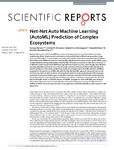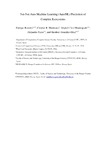Mostrar o rexistro simple do ítem
Net-net Auto machine learning (AutoML) prediction of complex ecosystems
| dc.contributor.author | Barreiro, Enrique | |
| dc.contributor.author | Munteanu, Cristian-Robert | |
| dc.contributor.author | Cruz-Monteagudo, Maykel | |
| dc.contributor.author | Pazos, A. | |
| dc.contributor.author | González-Díaz, Humberto | |
| dc.date.accessioned | 2018-08-28T10:48:08Z | |
| dc.date.available | 2018-08-28T10:48:08Z | |
| dc.date.issued | 2018-08-17 | |
| dc.identifier.citation | Barreiro E, Munteanu CR, Cruz-Monteagudo M, Pazos A, González-Díaz H. Net-net Auto machine learning (AutoML) prediction of complex ecosystems. Sci Rep: 2018:8:12340 | es_ES |
| dc.identifier.issn | 2045-2322 | |
| dc.identifier.uri | http://hdl.handle.net/2183/20980 | |
| dc.description.abstract | [Abstract] Biological Ecosystem Networks (BENs) are webs of biological species (nodes) establishing trophic relationships (links). Experimental confirmation of all possible links is difficult and generates a huge volume of information. Consequently, computational prediction becomes an important goal. Artificial Neural Networks (ANNs) are Machine Learning (ML) algorithms that may be used to predict BENs, using as input Shannon entropy information measures (Shk) of known ecosystems to train them. However, it is difficult to select a priori which ANN topology will have a higher accuracy. Interestingly, Auto Machine Learning (AutoML) methods focus on the automatic selection of the more efficient ML algorithms for specific problems. In this work, a preliminary study of a new approach to AutoML selection of ANNs is proposed for the prediction of BENs. We call it the Net-Net AutoML approach, because it uses for the first time Shk values of both networks involving BENs (networks to be predicted) and ANN topologies (networks to be tested). Twelve types of classifiers have been tested for the Net-Net model including linear, Bayesian, trees-based methods, multilayer perceptrons and deep neuronal networks. The best Net-Net AutoML model for 338,050 outputs of 10 ANN topologies for links of 69 BENs was obtained with a deep fully connected neuronal network, characterized by a test accuracy of 0.866 and a test AUROC of 0.935. This work paves the way for the application of Net-Net AutoML to other systems or ML algorithms. | es_ES |
| dc.description.sponsorship | Instituto de Salud Carlos III; PI17/01826 | es_ES |
| dc.description.sponsorship | Galicia. Consellería de Cultura, Educación e Ordenación Universitaria; ED431D 2017/16 | es_ES |
| dc.description.sponsorship | Galicia. Consellería de Cultura, Educación e Ordenación Universitaria; ED431G/01 | es_ES |
| dc.description.sponsorship | Galicia. Consellería de Cultura, Educación e Ordenación Universitaria; ED431D 2017/23 | es_ES |
| dc.description.sponsorship | Ministerio de Economía y Competitividad; UNLC08-1E-002 | es_ES |
| dc.description.sponsorship | Ministerio de Economía y Competitividad; UNLC13-13-3503 | es_ES |
| dc.language.iso | eng | es_ES |
| dc.publisher | Nature | es_ES |
| dc.relation.uri | https://doi.org/10.1038/s41598-018-30637-w | es_ES |
| dc.rights | Atribución 3.0 España | es_ES |
| dc.rights.uri | http://creativecommons.org/licenses/by/3.0/es/ | * |
| dc.title | Net-net Auto machine learning (AutoML) prediction of complex ecosystems | es_ES |
| dc.type | info:eu-repo/semantics/article | es_ES |
| dc.rights.access | info:eu-repo/semantics/openAccess | es_ES |
| UDC.journalTitle | Scientific Reports | es_ES |
| UDC.volume | 8 | es_ES |
| UDC.startPage | 12340 | es_ES |
Ficheiros no ítem
Este ítem aparece na(s) seguinte(s) colección(s)
-
GI-RNASA - Artigos [193]
-
INIBIC-RNASA-IMEDIR - Artigos [46]







